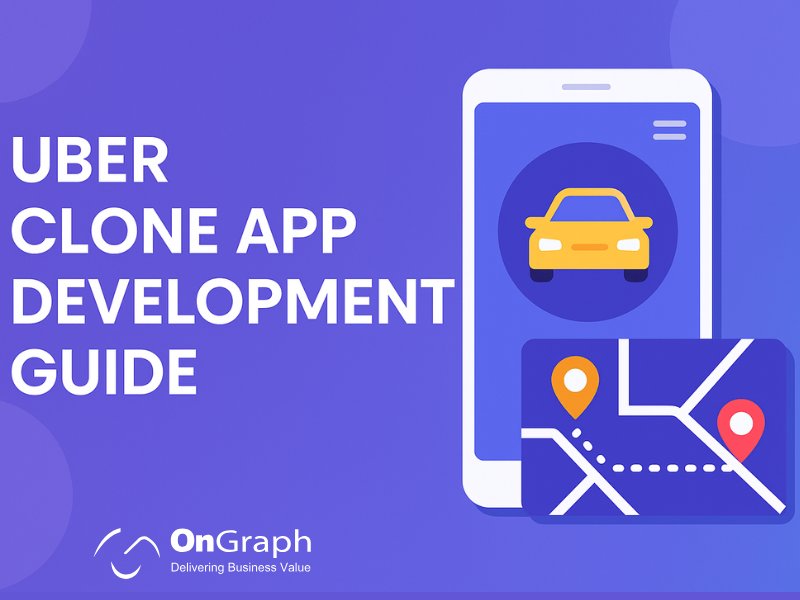In this article
- Why the Demand for Uber Clone App Development Is Growing?
- Real-World Market Examples That Prove the Opportunity
- How to Create a Taxi App: Complete Step-by-Step Roadmap?
- Essential Taxi App Features You Must Include
- Advanced Features That Give You a Competitive Advantage
- Uber Clone App Development Cost Breakdown
- Use Cases for Taxi Apps in 2025
- What Makes a Taxi App Successful? Key Insights?
- Mistakes to Avoid When Developing a Taxi App
- Why White-Label Taxi App Solutions Deliver Better ROI?
- Future Trends in Taxi App Development
- Conclusion
The global ride-hailing industry continues to grow strongly as consumers prefer digital transport over traditional models. Many entrepreneurs now explore Uber clone app development to launch a modern taxi business with lower investment, faster time-to-market, and proven scalability.
A clone-based solution helps you replicate trusted ride workflows while customizing the platform for your market needs.
This comprehensive guide explains everything you need to know before launching your platform. You will learn about development cost, features, ROI, real-world use cases, mistakes to avoid, and a step-by-step roadmap for building a successful taxi ecosystem.
Why the Demand for Uber Clone App Development Is Growing
Ride-hailing adoption increases every year due to convenience, transparent prices, and real-time tracking. Many regions also lack organized taxi services, creating huge opportunities for digital operators.
Key drivers for high demand include:
- Low upfront investment compared to custom builds
- Fast launch within weeks using a white-label platform
- Proven user experience from existing ride-hailing leaders
- Massive growth in mobile-first users
- Increased smartphone and digital payment penetration
- Shift from ownership to on-demand mobility
Businesses consider Uber clone app development because the model reduces risk while offering flexibility to scale across multiple cities.
Real-World Market Examples That Prove the Opportunity
To understand the potential of launching a taxi app, consider proven global patterns:
1: Africa’s Booming Digital Taxi Sector
Several African cities saw huge adoption of ride-hailing platforms due to low car ownership and high urban population. New apps grew fast due to localized pricing and safety features.
2: Europe’s Demand for Niche Ride-Hailing Apps
Airport transfer apps and corporate taxi platforms expanded rapidly due to professional service demand and low wait times.
3: Asia’s Multi-Service Super App Ecosystems
Ride-hailing apps integrated parcel delivery, rentals, and shopping into one ecosystem. This shows how flexible clone solutions can be.
These examples highlight major opportunities for new taxi startups using modern technology.
How to Create a Taxi App: Complete Step-by-Step Roadmap?
If you are planning to launch your own ride-hailing business, follow this blueprint to ensure a smooth process.
1: Market Research and Strategy
Study user behavior, competition, local taxi rules, and demand patterns. Determine your advantage.
Examples:
- Lower fares in non-urban areas
- Better safety in night operations
- Faster driver payouts
This research guides your pricing and feature set.
2: Choose Your Business Model
You must define how your platform earns money. Popular models:
- Commission on every ride
- Driver subscription plan
- Fleet-owned model
- Corporate contract model
- Franchise-based multi-city model
Each model suits different markets.
3: Partner with a White-Label Taxi App Development Company
Choose a partner with proven products and industry expertise. A White-Label Taxi App Development Company delivers a ready-made system with branding, customization, and launch support.
This reduces development time and ensures system stability.
4: Finalize the Feature List
Users expect seamless booking, tracking, and communication. Select features that match your business needs.
5: UI/UX Design
Simple and familiar design increases conversion. A clean interface reduces booking time and encourages repeat use.
6: Development, Integrations & Testing
Developers integrate maps, payment systems, routing, notifications, and real-time tracking. The app undergoes heavy testing for performance, GPS accuracy, and booking flow reliability.
7: Deployment and Launch
Apps are submitted to the Play Store and App Store. The admin panel gets deployed on your server. You can begin promotions after approval.
8: Post-Launch Optimization
Monitor data, user feedback, and ride performance. Add improvements based on real usage.
Essential Taxi App Features You Must Include
The success of your platform depends on the quality of its taxi app features. Below is a complete list organized for easy planning.
Passenger App Features
- Fast one-tap booking
- Real-time driver location
- Fare estimates
- In-app wallet
- Promo codes
- Booking history
- Multi-stop trips
- SOS button and safety alerts
- Scheduled rides
Driver App Features
- Easy registration
- Document upload
- Accept or reject ride requests
- Real-time navigation
- Earnings dashboard
- Withdrawal options
- Driver ratings
- Availability toggle
Admin Panel Features
- Region and city control
- Live ride monitoring
- Pricing rules
- Driver verification
- Heat map generation
- Dispute and support management
- Fleet analytics
- Transaction and settlement dashboard
A strong feature set helps position your platform as reliable and trustworthy.
Advanced Features That Give You a Competitive Advantage
Modern startups need more than basic features to attract users. Use these as upgrades:
- AI-based auto dispatcher
- Smart driver allocation
- Zone pricing rules
- Geofencing for specific areas
- Corporate ride accounts
- Multiple service categories
- EV taxi support
- Digital tipping
- Driver shift management
- Fleet performance analytics
These features create differentiation in competitive markets.
Uber Clone App Development Cost Breakdown
Many founders want to understand Taxi App Development Cost before investing. Cost varies depending on requirements.
Here is a simple breakdown:
| Component | Cost Impact |
| Passenger app | Medium |
| Driver app | Medium |
| Admin panel | Medium |
| Custom design | Low–Medium |
| Unique features | Medium–High |
| Map & real-time tracking | Medium |
| Payment integration | Low |
| Server infrastructure | Medium |
| Multi-city setup | Medium |
| Third-party APIs | Low–Medium |
When estimating the budget, consider hosting, maintenance, and marketing.
Use Cases for Taxi Apps in 2025
Taxi platforms now support multiple industries. This makes Uber clone app development more valuable.
1. Airport transfers
Dedicated airport services provide predictable fares and schedule-based bookings.
2. Corporate employee transport
Companies use apps to manage daily office commutes.
3. Hotel and hospitality transport
Hotels offer in-app ride booking to guests.
4. Women-safety-focused taxi services
Platforms target safety and comfort for female riders.
5. Rural and semi-urban taxi networks
Many regions lack organized cab services, creating a strong opportunity.
6. Healthcare and non-emergency transport
Hospitals use apps for patient transfers and medical staff transport.
7. School transportation
Parents track students in real-time through GPS.
Each use case has strong demand and supports long-term business growth.
What Makes a Taxi App Successful? Key Insights?
Success in ride-hailing depends on a few strong business pillars:
Fast go-to-market strategy
The quicker you launch, the faster you build market share.
High driver onboarding rate
More drivers mean shorter wait times.
Transparent pricing strategy
Users trust apps with clear price breakdowns.
Strong tech foundation
High uptime and accurate tracking improve customer experience.
Local market adaptation
Adapting to local rules and user behavior increases customer retention.
These insights help you shape a strong strategy from day one.
Mistakes to Avoid When Developing a Taxi App
Many new operators fail due to early mistakes. Avoid these issues:
- Overcomplicated features
- Choosing the wrong development partner
- Poor driver onboarding
- Weak safety measures
- No clear pricing plan
- Weak marketing
Learning from these mistakes helps you build a stable platform.
Why White-Label Taxi App Solutions Deliver Better ROI?
White-label solutions provide strong advantages for new businesses:
- Faster launch
- Lower risk
- Proven workflows
- Full customization
- Easy scaling
- Reduced technical downtime
- Lower ongoing maintenance
You can start earning quickly without a large upfront engineering investment.
Future Trends in Taxi App Development
To stay competitive, plan for future features:
- Electric vehicle fleet management
- AI-based demand prediction
- Multi-service integrations
- Subscription ride plans
- Eco-friendly ride options
- Chat-based customer support
- Advanced analytics modules
Staying aligned with these trends ensures stable future growth.
Conclusion
Entering the mobility market is a strong opportunity in 2025. Uber clone app development helps you launch a stable and scalable taxi platform quickly.
With the right features, strategy, and partner, your business can grow across multiple cities and compete with leading brands.
Choosing a reliable Uber Clone App Development Company ensures smooth development, fast delivery, and strong technical support. A white-label solution helps you reduce cost, accelerate launch, and build long-term value.
FAQs
An Uber clone app is a ready-made ride-hailing system. It includes core features like booking, tracking, and payments. Companies use it to launch faster and reduce development costs.
Costs depend on features, platforms, and customizations. White-label solutions reduce cost by using prebuilt architectures. Custom builds require more time and budget.
A white-label taxi app can be launched in a few weeks. Custom taxi apps may take several months due to extended development cycles.
Essential features include real-time tracking, payments, driver onboarding, pricing control, and trip history. Safety features are also important.
White-label apps offer faster launch and lower cost. Custom solutions offer deeper flexibility but need more time. Startups often prefer white-label options.
Yes. Most Uber clone solutions support region-based controls, geofencing, and multi-city pricing. Admins can expand quickly with the correct setup.
Review experience, portfolio, features, technology, and support process. Choose a partner offering strong customization and reliable post-launch support.
About the Author
Let’s Create Something Great Together!
Latest Blog















